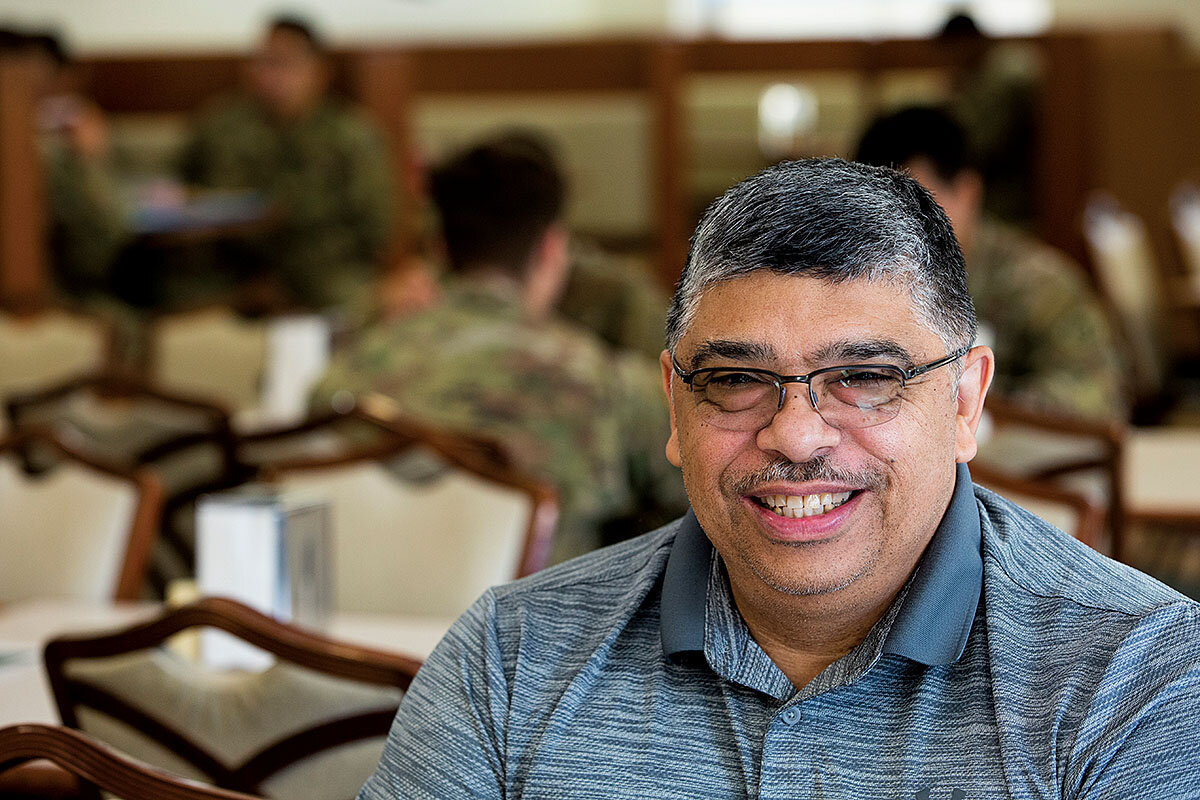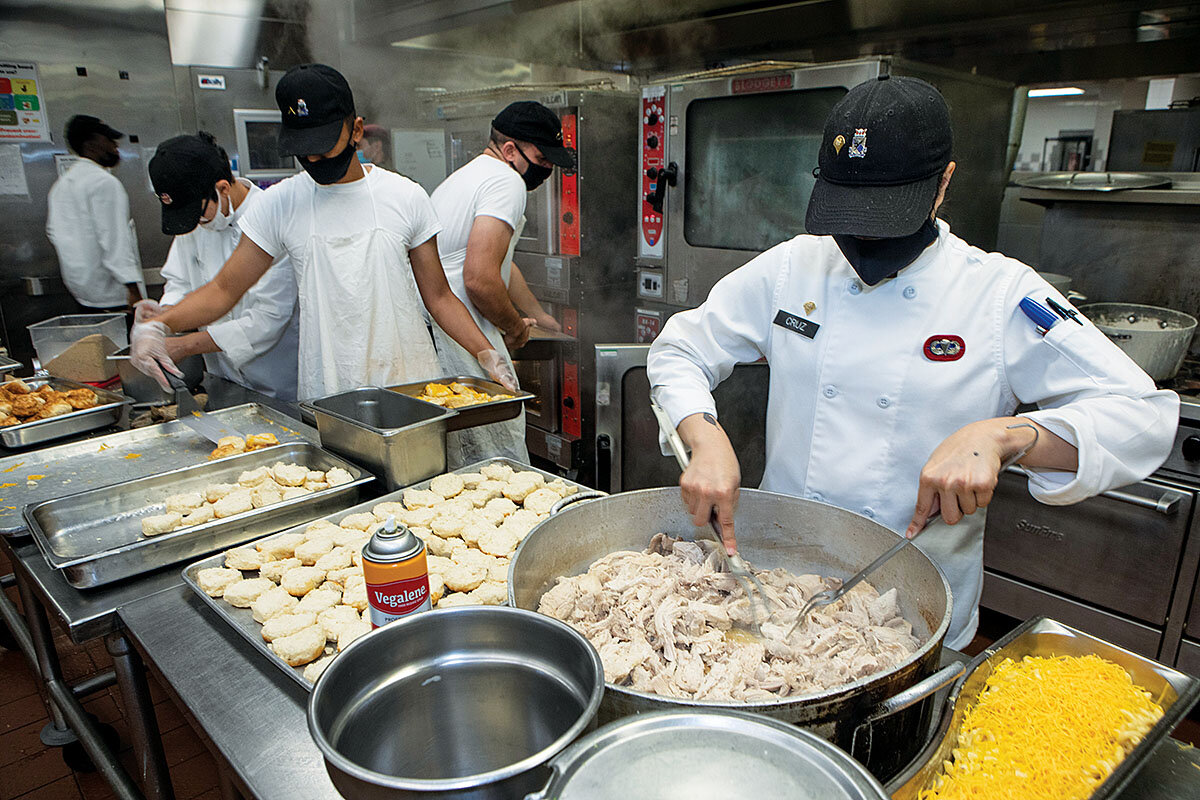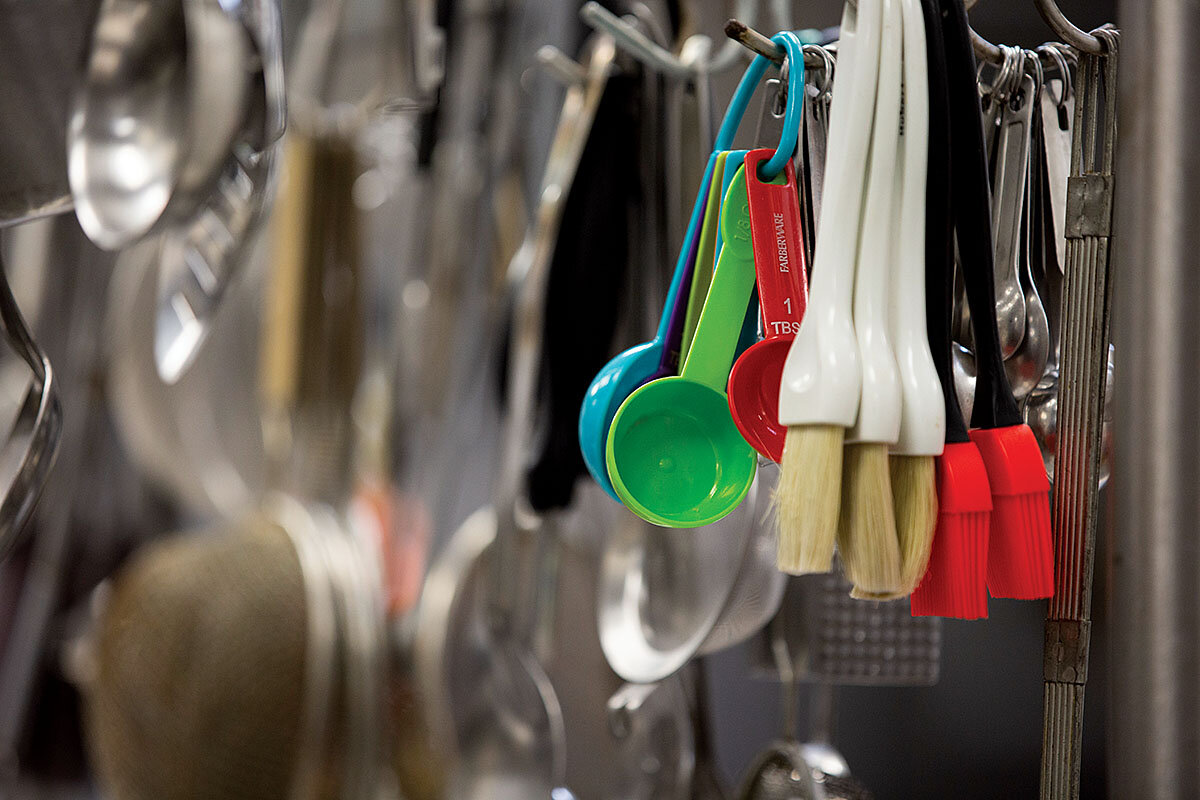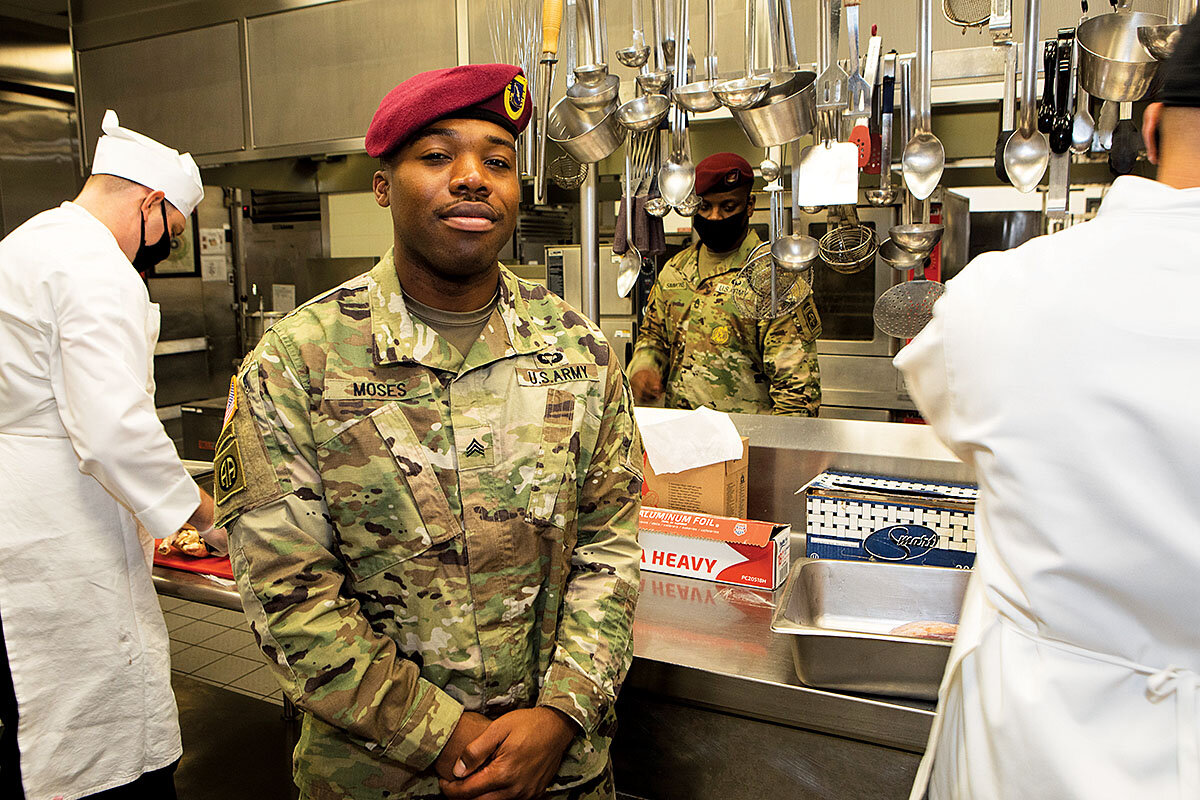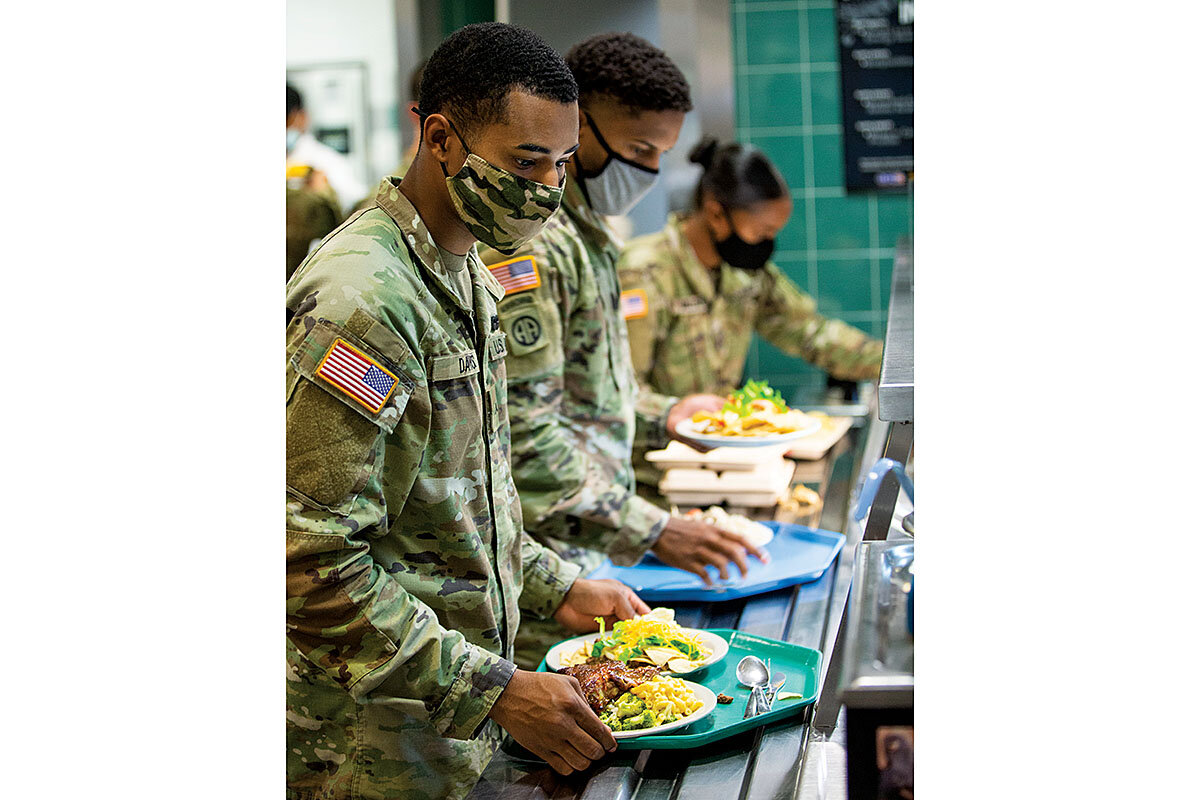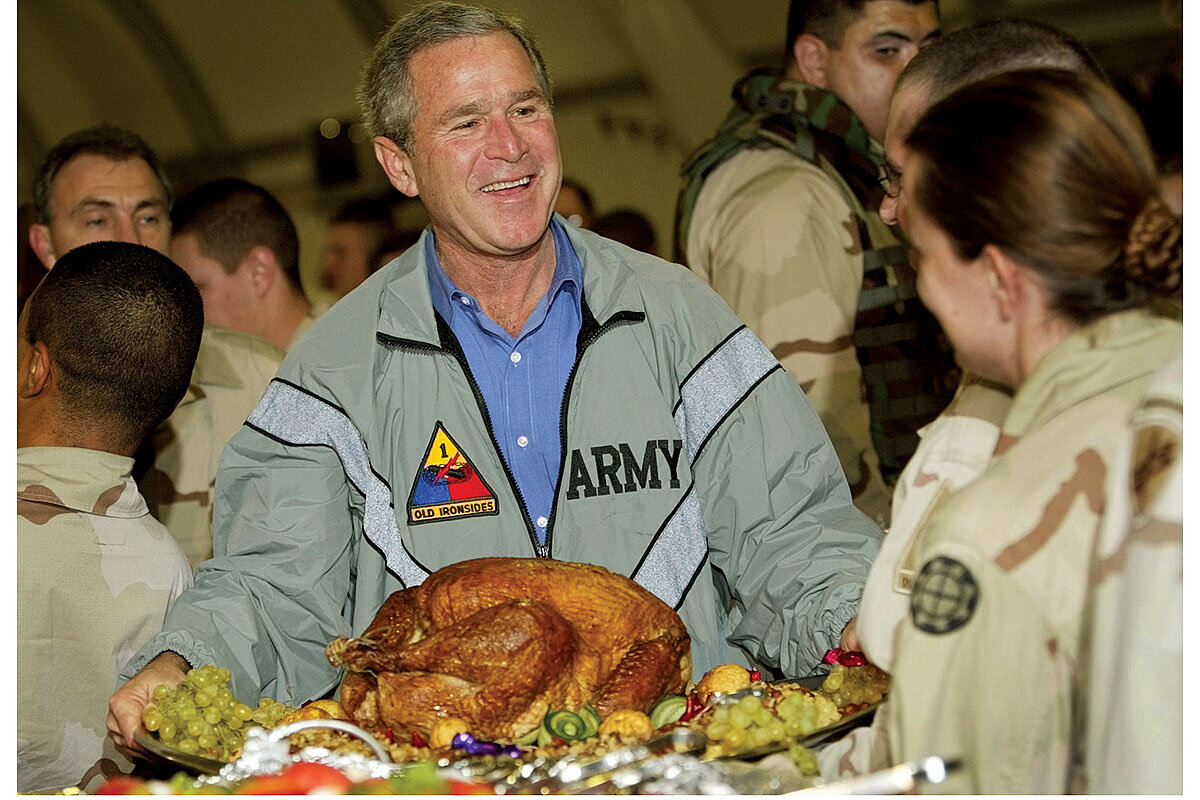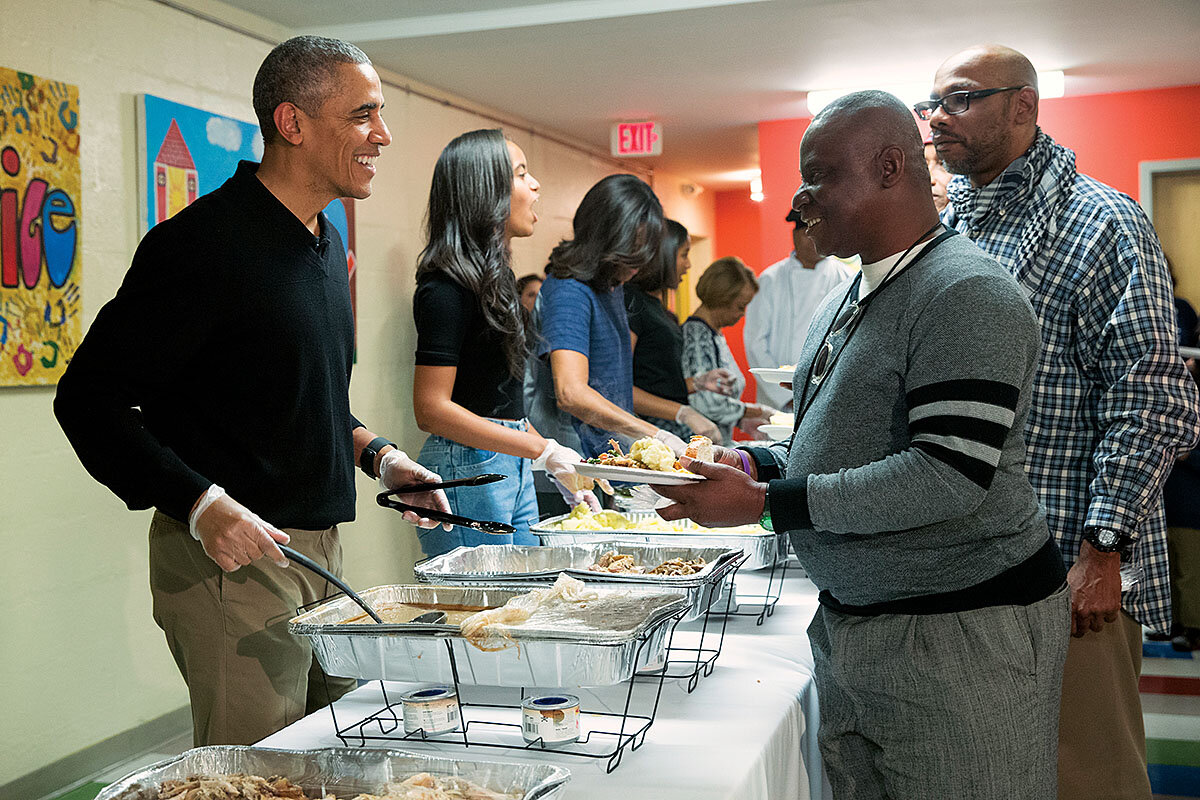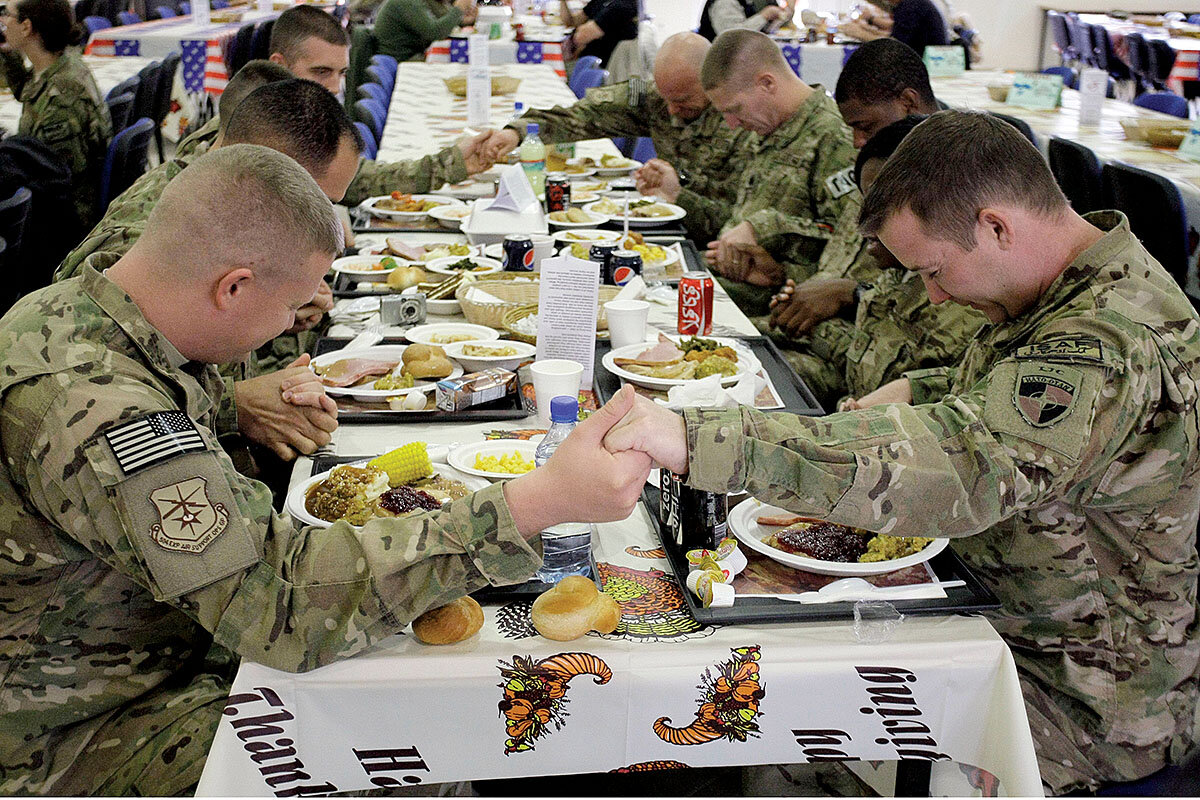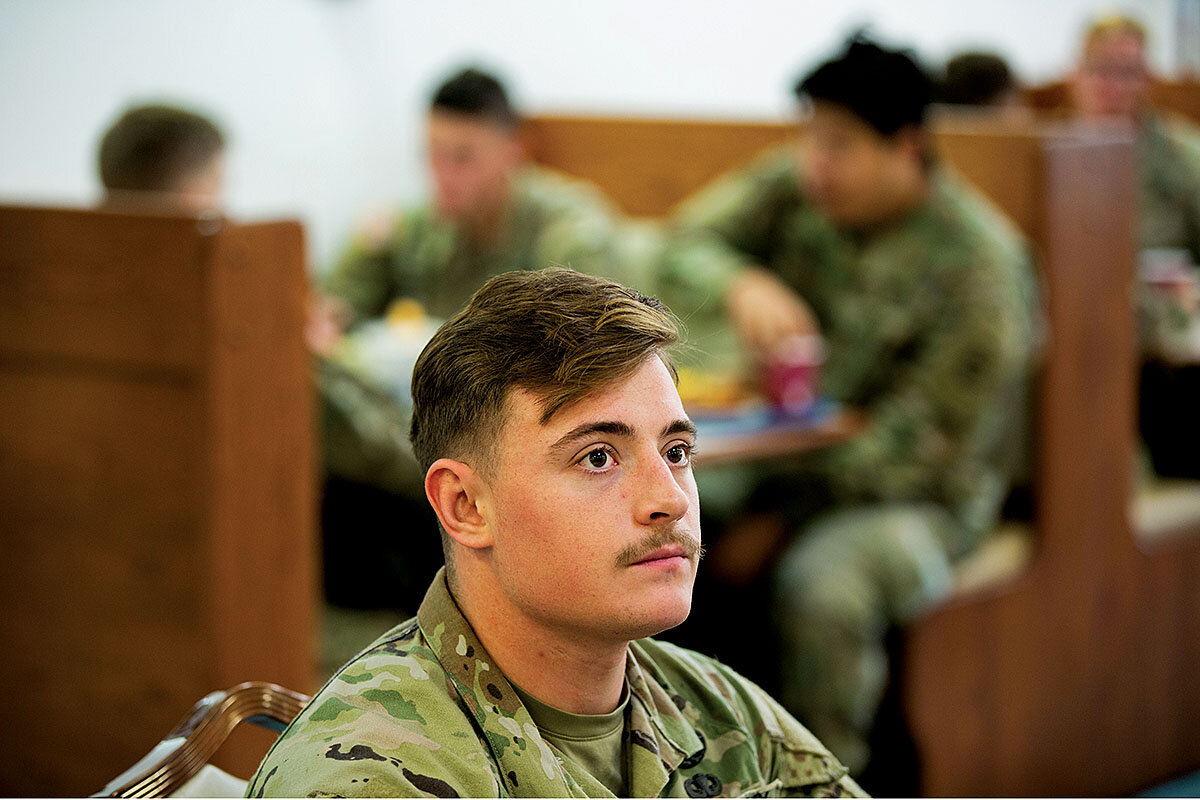Cooking for 15,000: How Fort Bragg pulls off Thanksgiving
Loading...
| Fort Bragg, N.C.
Princido “Tex” Texidor knew deep in his teenage heart that the El Conquistador wasn’t for him. The restaurant in the Puerto Rican town of Arecibo commanded nearly all his father’s time, and Mr. Texidor wanted no part of that.
But when he sat down with an Army recruiter in San Juan to discuss his future, the options felt uninspiring. “‘Artillery, tanks, infantry,’ the guy kept saying,” Mr. Texidor recalls. The young recruit consciously avoided one other category, until he finally had to choose. Then he gave in: “Food service” it was, he says.
As he waded into the Army’s mess hall bureaucracy, Mr. Texidor – whose boxer’s build is offset by a soft voice – realized he couldn’t quite shake El Conquistador, after all. Through more than three decades in the armed services, Mr. Texidor rose to eventually serve for three years as the Army’s chief food adviser during some of the military’s most active years in Afghanistan and the Middle East. According to cooks and culinary management specialists at Fort Bragg, Mr. Texidor’s sourcing, adaptability, and restaurant-rooted guidance helped the Army transform its food culture, refining what soldiers had long known as “slop” to more sophisticated cuisine, such as racks of ribs for a Thursday lunch at the 3rd Brigade Warrior Restaurant here on the base.
Why We Wrote This
A Thanksgiving meal is a way for U.S. troops to feel at home while serving in a distant corner of the world. To many, it’s also a moment to express their gratitude to each other, their country, and those who died defending it, not to mention to get some good chow.
Mr. Texidor sees the accomplishments as a reflection of what he learned from his late father: a mix of dedication, hard work, adaptability to challenges, and an embrace of tradition. And on Thanksgiving, that experience will culminate in what is likely the world’s biggest Thanksgiving feast: As many as 15,000 people are expected to sit down at Fort Bragg’s dining halls and express their gratitude to one another, their country, and those who perished defending it – and eat.
“Thanksgiving defines what I do, why I’m here,” says Mr. Texidor in an interview at a warrior restaurant on the base a few weeks before Thanksgiving. “It means everything.”
Aided by a platoon of cooks and supervisors, Mr. Texidor is in no small part responsible for making sure the “hot chow” is sourced and served at 12 dining facilities on Fort Bragg – the U.S. military’s largest base by population in the world – on the day they celebrate Thanksgiving here, which this year is Nov. 23. (They mark the holiday on an alternative day so cooks on the base can spend Thanksgiving Day with their friends or families.) The meals will be expectantly watched over by everyone from three-star generals to silver-haired veterans, from soldier moms to Green Berets. It will be replete with ice sculptures and decorations, all happening amid global supply chain problems that have had Army cooks squirreling away canned sweet potatoes for a year.
For Mr. Texidor and the base mess sergeants, the pressure is also on to make up for a pandemic-crimped celebration last year, when cooks somehow still managed to put together thousands of takeout meals amid COVID-19 outbreaks and facility closures.
This year, the Fort Bragg feast, Mr. Texidor’s spreadsheets conclude, includes 50 whole turkeys, 2,000 pounds of boneless turkey breast, 1,000 pounds of steamship round beef (a prime hindquarter cut), 1,500 pounds of fish and shrimp, 1,500 pounds of ham, and 5 whole roasted hogs, plus towers of sweet potato pie and other sides.
“Thanksgiving is our Super Bowl,” he says. “And we can’t lose.”
The logistics required to bring food to soldiers on the front lines of a conflict represent what the late military historian James Huston called “the sinews of war.”
Soldiers have always relied on their stomachs as much as their military cunning in times of conquest. Roman armies, for instance, often pillaged their way to domination, confiscating food as they captured territory, carrying salt with them to season the spoils of war.
By the Middle Ages, the English had begun to hone how troops are supplied. A thousand years ago, in the days of William the Conqueror, the daily requirement for 14,000 troops on the march was 28 tons of wheat flour.
Today, the U.S. Army lists subsistence, or food and water, as a “Class I” requirement. Unlike guns or vehicles, food needs to be resupplied constantly, which adds to the logistical complexity. In a way, that makes Mr. Texidor’s Thanksgiving, and the meals prepared by U.S. military cooks around the world, one of the most critical tasks in America’s $700 billion yearly effort “to deter adversaries and defend the United States homeland and its citizens,” as the undersecretary of defense wrote in the 2021 Defense Budget Overview.
Fortunately, Mr. Texidor will have some help with the turkey.
For 50 years, the U.S. Defense Logistics Agency has fulfilled orders from military cooks. It’s a byzantine task that peaks on Thanksgiving. Whether it’s the 127 U.S. troops stationed in Canada, the 381 troops in Saudi Arabia, or the 52,280 troops here at Fort Bragg, the Army extends to every war fighter two special holiday meals – Thanksgiving and Christmas. Those meals represent a powerful ritual for a volunteer force. They are also a mean feat to pull off, given that the U.S. military operates some 750 bases in 80 countries.
Indeed, consider the culinary challenge at Fort Bragg alone. Nestled amid the southern yellow pine of central North Carolina, the base is a sizable city in its own right: 270,000 people spread across 500 square miles. Most of the people on base will celebrate Thanksgiving in their homes. But about 15,000 will visit one of the many dining halls for their drumsticks and stuffing on Nov. 23.
Robin Whaley, for one, thrives on making sure every base will have enough food. From a computer adorned with pictures of troops enjoying Thanksgiving feasts, Ms. Whaley, a 33-year logistics veteran, helps lead 300 specialists tasked with sourcing, procuring, packaging, and delivering nearly 10,000 turkeys around the world. Her unit is headquartered in Philadelphia.
Hundreds of thousands of orders go out to prime suppliers – companies like Smithfield Foods and US Foods – and those orders are tracked to warehouses. That is a complicated task made particularly difficult this year by the supply chain issues that have gummed up the logistics agency’s work, as well as the U.S. economy.
But preparation is a hallmark of the military. Turkeys aren’t any different. While millions of Americans scour aisles for yams and plump birds in the final weeks before the holidays, Ms. Whaley begins placing orders in March. As those shopping lists are filled, her staff monitors the orders’ movement from the poultry farms to regional storage centers. There are weekly “holiday tracker meetings” to address problems.
Individual dining facility managers then place the orders that bring the food on trucks and planes, and at times on pack mules, to their mess hall refrigerators. Staff Sgt. Jamie Contreras, one of the cooks at Fort Bragg, says his preparations for Thanksgiving start nearly a year in advance, when space in the storage rooms allows the staff to start gradually restocking.
“For me, the preparations start as soon as the holidays are done,” says Sergeant Contreras. “You start building your pantry right away until you have a robust menu.”
Inevitably, though, hiccups arise with deliveries – and sometimes take unusual ingenuity to resolve. One civilian kitchen supervisor at Fort Bragg recalls during a stint in Afghanistan that a nongovernmental organization helped him source several whole hogs in time for Thanksgiving – not an easy task in a Muslim country where most people don’t eat pork.
“While soldiers are deployed away from their homes and families, knowing that they can celebrate such a familiar holiday or meal is critical,” says Ms. Whaley of the Defense Logistics Agency’s subsistence unit. “Food is emotional, and just having that meal that you’re familiar with – that mac and cheese, that ham, that stuffing – all of those comforts of home give a little more comfort while they’re away. Also, a lot of war fighters who are stationed away don’t have the convenience of going to the supermarket, so we have to make sure they have everything they need – down to the butter.”
Then comes the actual cooking itself. Mr. Texidor – now a civilian contractor whose experience the Army leadership leans on to help guide the preparations – says the kitchens at Fort Bragg start humming 14 hours in advance, and everything is done according to procedures fine-tuned by each dining facility.
The hogs go on the fire the evening before to cook through the night, watched over by resident smoker expert Sgt. Robert Moses. Last year, he helped roast three whole hogs for the 82nd Airborne. “I can’t even tell you how important [Thanksgiving dinner] is for morale,” says Sergeant Moses.
The turkeys are slipped into massive ovens in the morning, along with the steamship beef. Stuffing, gravy, and mashed potatoes are prepared on precise schedules in bins and bowls the size of small bathtubs.
“It’s all industrial, things you might find in a cruise ship or major hotel, designed for mass feedings,” says Mr. Texidor. “It’s crowded, and we have different teams preparing meats, starches and veggies, and salad. It’s a team concept where you have three or four cooks per team to ensure that everything is set up right and in a timely manner.”
The process “is pretty rough” for the cooks, says Sgt. Maj. John-Joseph Williams, a longtime member of the Army who has cooked for the Joint Chiefs of Staff and served as a personal aide to a three-star general.
Each facility sets its own decorations, which are judged by military higher-ups, and the cooks summon their inner Gordon Ramsay on presentation. The steamship rounds are laid out to carve alongside hazelnut-brown roasted turkeys.
“The serving line is slower because obviously [celebrants] are trying to admire what’s on the line, because everything is decorated and garnished and looks so good and delicious, so everybody is eating with their eyes first,” says Mr. Texidor. “It’s open seating. You sit wherever you want to and just enjoy the company of everybody there. A lot of times command generals or sergeant majors will go through the dining room and greet people. It’s a very family atmosphere.”
Mr. Texidor acts as chief inspector. He goes around to all the facilities on Thanksgiving Day, doing spot-checks, making sure the kitchens are clean and the food is being prepared correctly – and on time.
He doesn’t mind being in a kitchen when everyone else is celebrating. It’s what he did growing up.
“My family, we all worked in the restaurant, and we used to sell the Thanksgiving dinner, so we spent Thanksgiving at the restaurant,” he says. “That’s always part of you, regardless of where you go.”
The care that goes into preparing the Thanksgiving meal at Fort Bragg shows how food service has evolved in the military. It’s what Mr. Texidor calls a shift to a more “culinarian” outlook.
In the old days, soldiers ate in a mess hall. Those long ago were replaced by “d-facs” – dining facilities. Now troops eat at “warrior restaurants.”
Mr. Texidor says part of the transition is simply understanding the power of “lickies and chewies” – little gifts and treats that can elevate a meal, even ones as mundane as MREs, or meals ready to eat, that soldiers consume in the field.
Mr. Texidor served under Lt. Gen. Russel Honoré, who took command of a lawless New Orleans in the days after Hurricane Katrina. He watched as the general worked to change the food culture at Fort Bragg.
“General Honoré looked around at all the ... restaurants on the base and said we should be serving food that competes,” says Mr. Texidor. “Soldiers shouldn’t have to pay for good food.”
To hone their skills in the new culinary environment, the cooks here and on other military bases periodically take part in competitions as part of their training. One was held in late October at Fort Bragg’s Joint Culinary Center, featuring the best cooks on base.
Styled on the Food Network’s cooking show “Chopped,” the contest involved giving each contestant a mystery basket of several food items, from which they had to prepare a meal in a set amount of time.
Unlike on TV, however, the cooks weren’t judged just on presentation, creativity, and taste. This being the military, they were also evaluated on their personal appearance, down to whether their fingernails were clean and undershirts properly tucked.
Even after struggling through the inspection portion – he forgot to wear an undershirt, among other dings – Sgt. Taehoon Yoon won with a dish of sweet-and-sour pork. His prize: a spot on the base’s competitive culinary team, which goes up against other bases, and a tandem skydive with the Golden Knights, the Army’s aerial parachute demonstration team.
“When it comes to Thanksgiving, everything that [the Army cooks] have gone through to get here, they get to showcase,” says Mr. Texidor.
For one of the food service supervisors at Fort Bragg, preparing the Thanksgiving meal is important for reasons that go beyond simply duty. It carries personal meaning. He’s been out in the field during the holiday and knows, like many career soldiers, what the sight of a drumstick can evoke in a time of war.
A decade ago, Sgt. 1st Class Richard Honrine was stationed with 24 other soldiers in a far-flung mountain redoubt in Afghanistan. On Thanksgiving Day, he heard a faint chop-chop of rotors. A quick drop of mermites, or packing boxes, meant a fried turkey dinner for him and his mates. (Yes, the Army supplies small portable fryers in those kits.)
“It meant the world to us – it was such a connection,” says Sergeant Honrine. “I’ll never forget it.”
Mr. Texidor personally carried such meals on helicopters at one point in his career. “For a soldier to know that the Army has food for us regardless of where we may be, and that we can get almost any type of food to them, is a big deal,” he says.
As he eagerly awaits Thanksgiving at Fort Bragg, Army Spc. Austin Watz, from Great Falls, Montana, fully agrees. He is dipping into some well-sauced pork ribs at the 3rd Brigade’s Warrior Restaurant.
Specialist Watz looks forward, in particular, to having three- and four-star generals take turns serving food to soldiers – a
measure of thanks in a gravy pour.
He likes the camaraderie that pervades the cafeterias at the holidays, too. Thousands of war veterans who have settled in the area come back on base to sit next to young men and women fresh from basic training. Gold Star mothers and fathers sit shoulder to shoulder with company commanders.
“It is a time for us to be treated like individuals,” says Specialist Watz. “Thanksgiving, for a lot of us who are far from home, is our most challenging time of the year. So getting a Thanksgiving meal really helps. It’s a reminder that this is our second family.”






